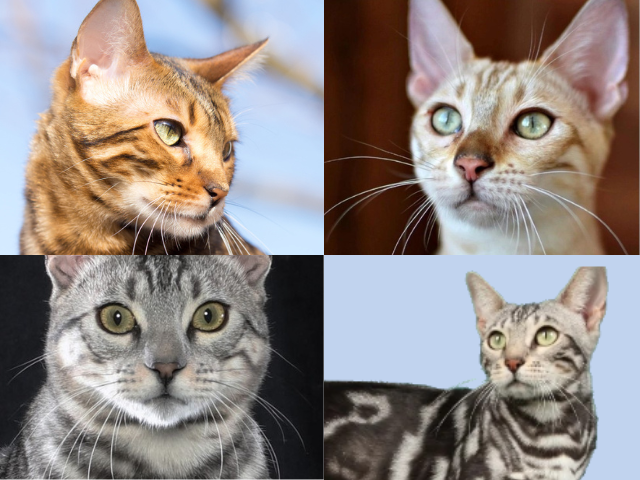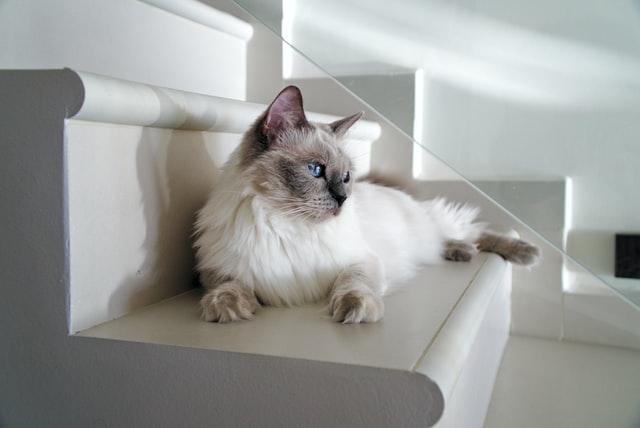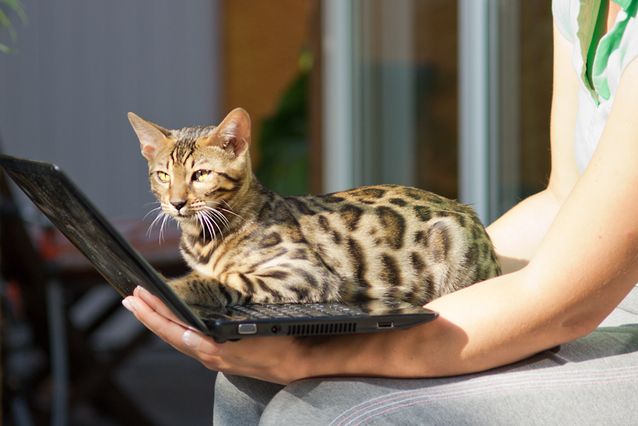In this article, I’m going to compare two increasingly popular cat breeds- the Savannah and the Bengal.
As a Bengal cat owner, conveying what it’s like to own one as a pet was easy.
Having never had a Savannah however, meant much research was needed.
For each cat breed this article will look why the following are important when deciding which will make the better pet:
- Their wildcat origins
- Fur patterns
- Colouring
- Size
- Temperament and activity levels
- Potential health problems
- Cost
So make sure you carefully read each section in order decide which breed is best for you.
Choosing a Breed Overview
Before I go into comparing Bengals and Savannahs, it’s important to know as much as you can about a potential pet before you commit to buying one.
There is much to consider.
I researched many aspects of owning a Bengal- much of which was written up as articles or as part of my blog.
There were areas I hadn’t really considered- such as how to identify scams and unethical breeders.
This is particularly pertinent to Bengal and Savannah cats.
But for now let’s look at each breed in detail, starting with their ancestry and why that’s relevant…
1. Which Wildcats Do Bengals and Savannahs Originate From?
Bengals
The Bengal breed came into existence after an original crossing of a domestic cat with the Asian leopard cat.
Asian leopard cats are small, typically the size of an average domestic cat, although this does vary according to where in Asia they are found.
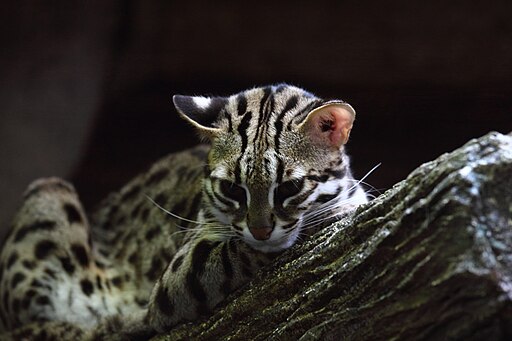
Image by paVan CC BY 2.0 via Wikimedia Commons
Their fur is spotted– hence the resemblance to a leopard.
These dark spots can be ‘solid’ or rosetted with elements of marbling.
You will also notice stripes on the face which can run along top of the back.
Geography again determines the colour of a leopard cat’s fur, which can range from light brown right through to grey.
In contrast, their lower/underside from the throat running down to the beginning of the tail is white/lighter in colour.
Savannahs
Savannah cats are the result of breeding between a domestic cat and an African serval cat.
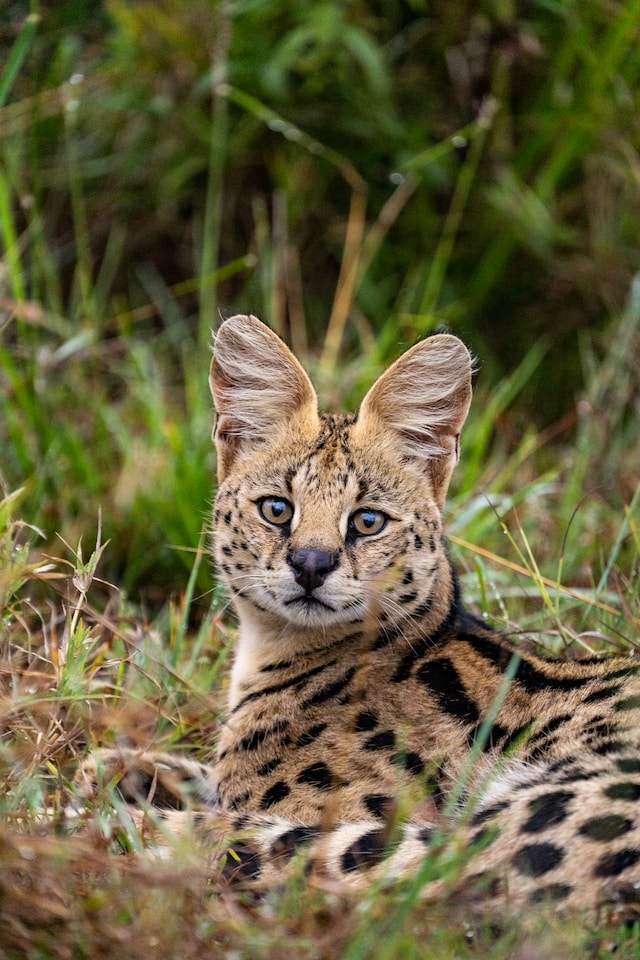
Servals are found across Africa and are a lean, long-legged, long-bodied medium-sized wild cat– a sort of mini Cheetah.
They too have dark spots- though some of these are positioned in such a way that they resemble stripes.
A serval’s fur is typically golden-yellow, and as with the Asian leopard cat, they have a white/lighter coloured underside.
Why This Is Important
Both Bengals and Savannahs are more closely related to their wild cat ancestors than most other domesticated breeds.
This means they still retain elements of ‘wild cat’ in them in both how they look and behave.
Early generation hybrid cats, particularly F1 (the first generation), F2 (the second generation) are more likely exhibit wild traits.
Most Bengals sold as pets are F4 or lower generations- that is, a Bengal/Bengal mix.
If you’re interested, ‘F’ stands for ‘filial.’
Anyway, this has implications with regards to behaviour and also cost.
Now we know where the Bengal and the Savannah came from, let’s move onto what they look like…
2. What Fur Patterns Do Bengals and Savannahs Have?
Bengals
Since their emergence as an officially accepted breed in 1986, the Bengal look has diversified greatly.
Bengals fur patterns fall into two main categories, spotted and marbled, although you may also see a hybrid ‘sparble’ mix which is not officially recognised.
Solid, dark or black spots are common amongst Bengals but it is rosetted spots that are most sought after.
These rosettes can be subdivided into further categories (like the donut/doughnut rosettes shown below), many of which are meant to replicate patterns on larger wild cats such as leopards and jaguars.

I have written an article dedicated to this subject, so if you would like to find out more about Bengal cat rosetted patterns, see ‘Bengal Rosetted Patterns: The Beginner’s Guide.’
Marbling is essentially a blend of dark stripes that swirl and align horizontally.

Savannahs
There is much less variety in Savannah patterning compared to Bengals.
Savannah cat spots are solid.
They can be round, oval or more elongated.
Sometimes spots are so closely knit, they appear to create stripes.
Depending on the base fur colour, you may see black spots, dark brown or dark grey, or for ‘snow savannahs’, beige.
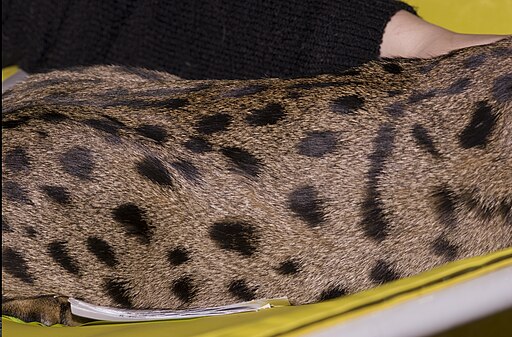
Rosettes can be found, however this means a Bengal has been used somewhere….
Savannahs too can possess the swirling marble pattern, but if you intend to show your cat, note that marbled savannahs aren’t officially recognised.
Why This Is Important
With more diversity in Bengal fur patterns, a prospective owner will have to decide which (if any) they have a preference for.
Rosetted Bengals are generally more sought after and therefore may not only be harder to find, but will cost more.
Bengals are the only breed with true rosetted spots.
Savannah cats retain the solid spots of the serval cat.
So as mentioned, any rosetting you come across means a Bengal has been introduced somewhere into that Savannah’s line.
If searching for a cat for show purposes, then certain pattern types with be more desirable as they will have to adhere to breed standards.
That’s patterns dealt with, now let’s compare background fur colours…
3. What Colour Is A Bengal and Savannah Cat’s Fur?
Bengals
Alongside their fur patterning, Bengal colouring has also become more diverse.
The most common are brown Bengals, but one will find snow, silver and even blue.
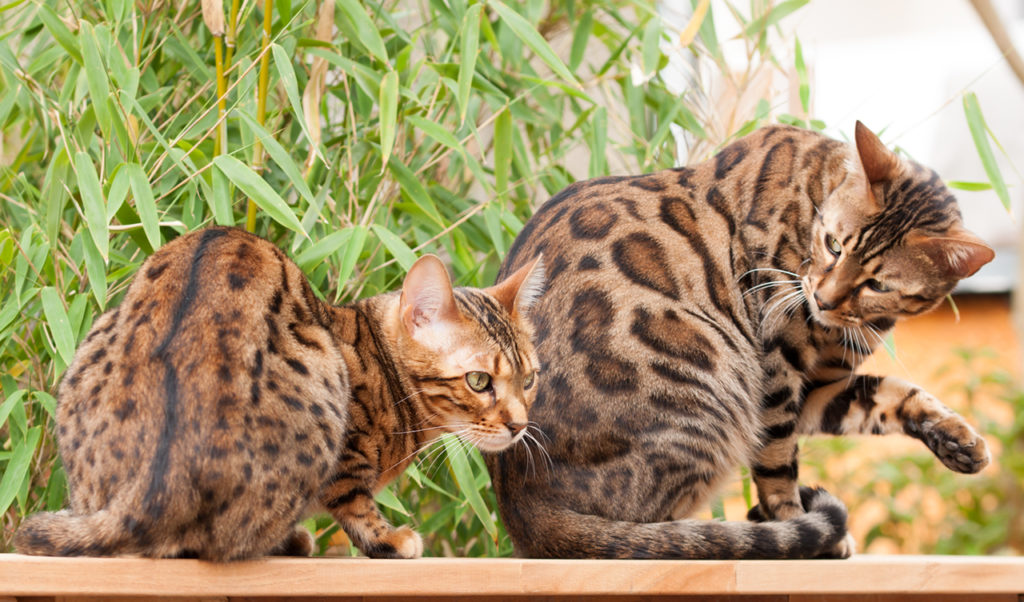
Even within these ‘umbrella’ colour groupings there are sub-categories.
Brown Bengals can be light, dark, red or more golden.
Snows are a range of whites and creams as you might expect, but this is heavily dependent on which of the 3 main snow sub-categories they belong to (see ‘Snow Bengal Cats: The Most Definitive Guide‘).
Silvers are, well silver (or grey I suppose), but one will come across silver snows and silver blue Bengals (see ‘Silver Bengal Cats: The Definitive Guide‘)
When you add charcoal and black (also known as melanistic) traits, you have a range of cat looks to satisfy most tastes.
Bengals will typically have a white coloured belly, inner legs and chin as this is what the breed standard considers desirable.
Savannahs
There are four officially accepted Savannah colours.
These are brown, black, silver and black smoke.
The brown, or to give it the official name, the ‘brown spotted tabby’ can be light or dark brown right through to golden.
Brown Savannahs are the most common and most closely resemble the Serval.
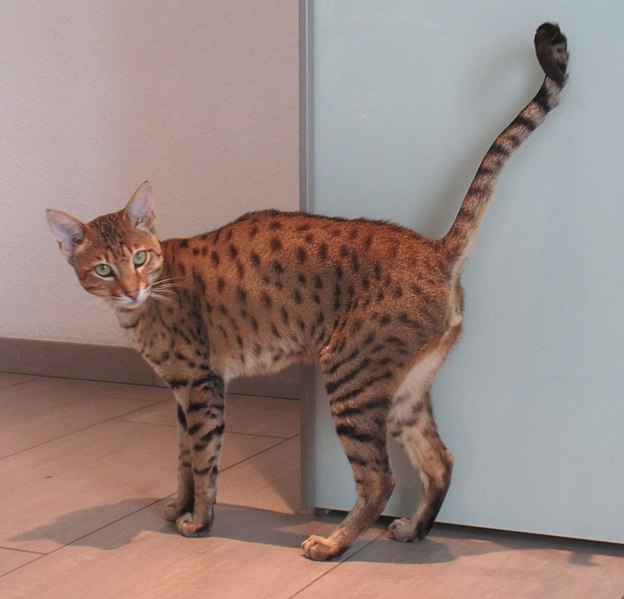
Black/melanistic Savannahs like their melanistic Bengal counterparts appear to be completley black– like a mini panther.
However, upon closer inspection, spots that are darker than the base fur will be visible.
Silvers- silver spotted tabby cats, are silver/grey as you would expect and are the second most popular colour.
Black smoke Savannahs differ to blacks in that they have a white undercoat for contrast.
Savannah non-standard colours, that is, those not officially accepted include:
- Blue- a washed-out black look
- Cinnamon
- Chocolate
- Fawn- a lesser cinnamon colour
- Lilac- a diluted ‘chocolate blue’
- Snow-a white coat
Why This Is Important
If looking for a Bengal or Savannah as a pet, then cat colouring will be down to personal preference.
You will not care too much whether a fur colour is officially recognised or not.
Colour does have an impact on cost with brown Bengals being cheaper to buy than silvers or snows.
I couldn’t find anything to suggest fur colour affects Savannah prices in the same way.
Colour wise, there is more variety with Bengals- especially when you add their fur patterns into the mix.
So in a sense it’s the variety in Bengal appearance to consider against the more conformed yet rarer look of the Savannah cat.
If showing is important to you, then you’ll clearly need to select a cat colour that adheres to the breed standard.
4. How Big Are Bengal and Savannah Cats?
Bengals
Most adult Bengal cats weigh between 6-15lbs (2.7-6.8kgs), but some specimens have been known to reach the 20lb (9kg) plus mark.
Males will be towards the higher end of this range- 10-15lbs (4.5-6.8kgs) and females, the lower- 6-10lbs (2.7-4.5kgs).
Expect a Bengal cat length of up to 18 inches (45.7cms) for fully grown adults (excluding the tail).
A Bengal cat height (based on what I could find), measured from the base of front paw to top of the head- ignoring ears) is around 15 inches (38cms).
Bengals tend to fall at the higher end of the domestic cat weight/size range, and are stockier, and more muscular, particularly big males.
Having said that, my own female Bengal is actually quite small.
Savannahs
Early generation Savannah hybrid cats- that is F1 and F2 generations, are the biggest as they are genetically more similar to the African serval.
They range in weight from 15-20lbs (6.8-9.1kgs) with larger specimens sometimes peaking at over 25lbs (11.3kgs).
Even F3 Savannahs are bigger than most domestic cats.
As generations progress and get further away from the original serval/domestic cat cross, sizes start to get smaller.
Weights range between around the 10-14lbs (4.5-6.4kgs).
Savannahs are taller, longer and leaner.
In fact the tallest domestic cat officially recorded was a Savannah at just over 19 inches (48 cms).
Yours probably won’t reach those lofty heights, but may well be around 16 inches (41 cms) for early generations, dropping to around 11 inches (28 cms) for the lower.
Why This Is Important
Bengals are generally smaller than Savannahs, certainly early generation Savannahs.
And females for both breeds are typically smaller than males.
Knowing what size your cat should be or will become is important for two main reasons.
Bigger, more lively cats may not be suited to smaller homes (See ‘13 of the Best Cats for Apartments and Small Homes’).
Equally, weight in a particular is a good indicator of health be it too high or too low.
Sudden weight loss for example may indicate an underlying health issue.
Let’s now move away from the physical aspects of the breeds and look at the mental…
5. Temperament and Activity Levels
Bengals
Bengal cats, particularly as kittens are inquisitive, playful, and high energy.
My kitten would often bound around the living room of evening, expending pent up energy, as if it was some kind of racing circuit.
Their inquisitive, playful side make for pets you can interact with.
Being able to play games of fetch or take a Bengal for a walk isn’t uncommon.
Of course this can also have a down side, as their inquisitive nature, particularly when young, can get them into trouble or cause breakages, spills and damage.
Bengals love to investigate anything new and show interest in tasks you may be carrying out- seemingly trying to get involved on occasion.
And they will, more often than not, come to ‘greet’ you when returning home.
They are not typical lap cats although my Bengal has her moments- sharing a sofa with me, particularly in winter.
Being reasonably intelligent cats, they can learn to open doors and windows on their own, and can be taught tricks/basic commands.
They are particularly fond of heights and climbing- shelves, tops of sofas and even door frames.
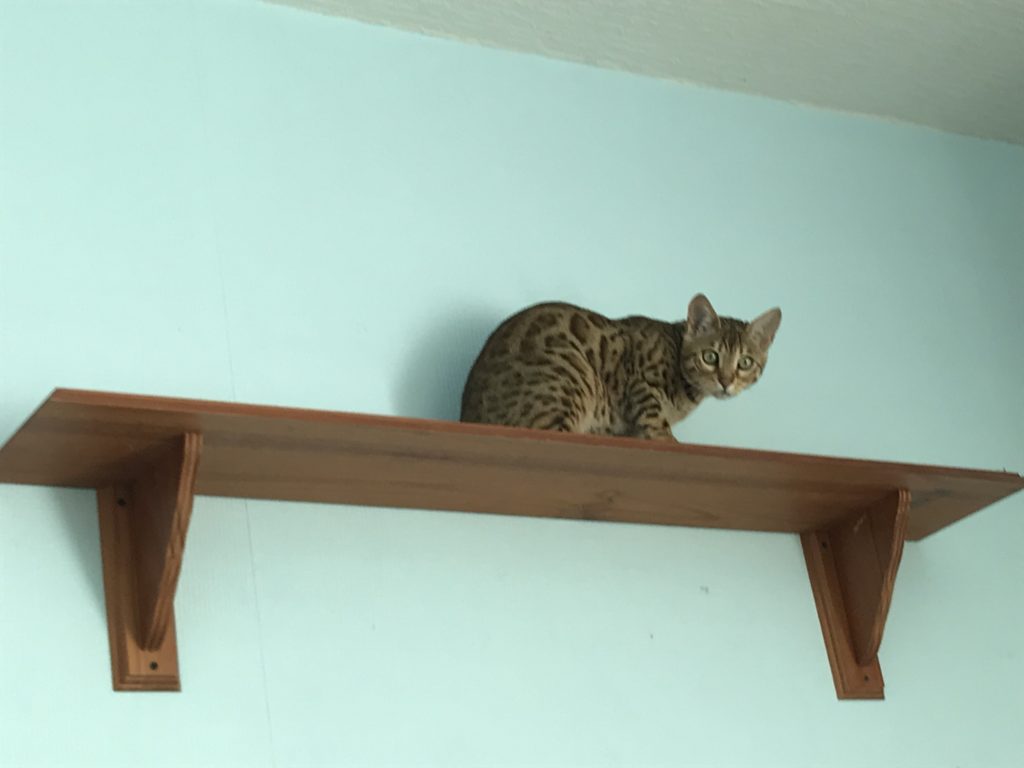
Bengals are talkative cats, making a range of miaows, chirps and mine makes a noise that represents an “Oh” sound.
They even seem to know when it’s their turn to ‘speak’.
Of course they’re particularly vocal around feeding time, especially if fresh chicken is involved.
Many sites mention Bengals have a love of water and this may well be true for many, but not my own.
She does like a stroke and will often ‘instruct’ me to continue should I stop prematurely.
Savannahs
Like Bengals, the Savannah cat is known for its intelligent, inquisitive nature and being highly active.
An early generation hybrid cat is said to be more demanding and require more attention, with those with less serval cat ‘in them’ acquiring more domesticated cat traits whilst still retaining the loyal, ‘dog like’ qualities.
As with Bengals, intelligence and curiosity are a double edged sword.
Savannahs like to play and interact with their owners through playing games like fetch and catch or being taken for walks on a leash.
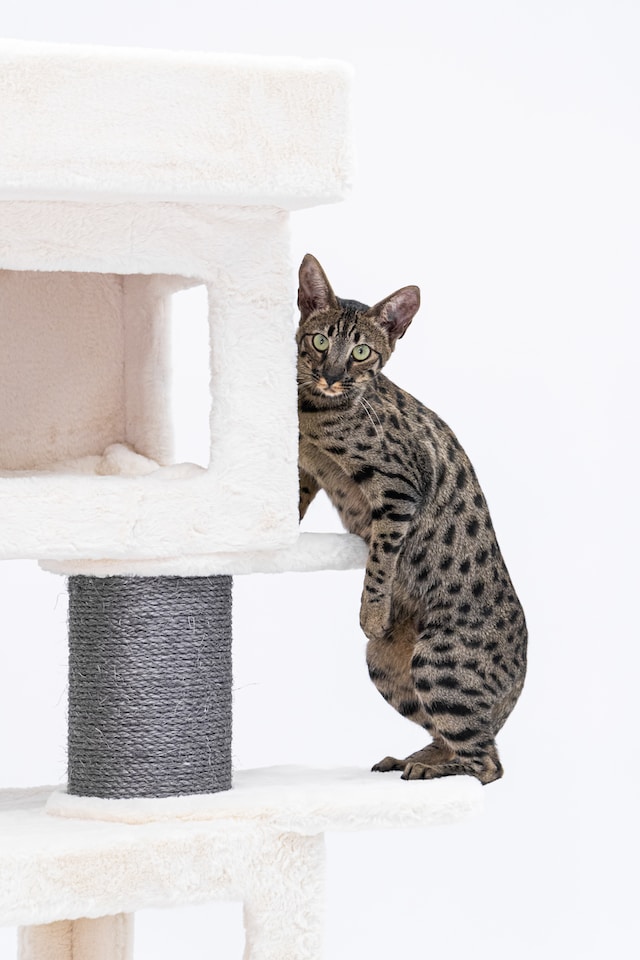
But their inquisitive nature and ability to learn can lead to issues, which is why some owners have coined the term ‘Savandalism’ to describe their behaviour and have resorted to baby proofing parts of their home.
They are not considered lap cats, but like Bengals, display affection through rubbing or butting of their head.
The breed is typically water loving with stories of them darting into running showers or playing in bath tubs.
Savannahs talk if they want attention often with a small, unassuming voice, although some individuals are on the louder side.
Why This Is Important
Firstly, one should note that individual cats may not entirely conform to the general or all traits of the breed i.e. their personality types will be different.
Much of their temperament will depend on how they were handled when young.
In general, Bengals and Savannahs have much in common.
Both breeds are active, intelligent and playful.
The downsides to this is that they need attention and can break things and cause damage to your home, especially when young.
So if you’re house proud or looking for a lap cat then neither breed would be recommended.
Equally, neither breed are particularly suited to being left alone for lengthy periods of time.
And expect an occasional noise or an attempt to get into your bedroom at night if they want attention.
Before considering acquiring any pet, you must also consider the living environment you can provide.
Although both can be house cats, being active and energetic means they are more suited to larger living spaces.

However, for those who have smaller homes, a cat wheel or taking your Savannah or Bengal for a walk can help compensate.
They are some health issues that may affect both breeds, which we will touch on next…
6. Potential Breed Related Health Problems
Bengals
The Bengal cat breed requires genetic screening for defects that could cause life-threatening health problems later in life.
This screening is for Pyruvate Kinase deficiency (PK def), which results in a host of symptoms including anaemia and Progressive Retinal Atrophy (PRA), a degenerative eye condition.
Hypertrophic Cardiomyopathy (HCM) which causes heart failure, is believed to have a genetic component, but currently there are no genetic tests for Bengals for this condition.
Savannahs
Savannahs have two potential inheritable conditions to be aware of.
These are PK def and PRA.
They were introduced from the domestic cats used early in development of the breed.
As with Bengals, these conditions can be identified in kittens through genetic screening.
Why This Is Important
These conditions can have implications with regards to the quality of life and life expectancy of your cat.
Providing you purchase your kitten/cat from a reputable breeder who can prove relevant testing has been carried out, then these conditions should have no bearing on whether to choose a Bengal or a Savannah.
Bengals have the additional potential problem of HCM, but again a reputable breeder will be able to prove that adult cats have been scanned, to what age, and/or whether the kittens are from screened lines.
Both cat breeds need some form of vaccination as kittens, however regulations differ according to where you live.
Some may not be needed if intending to keep your cat indoors.
Again though, most reputable breeders will sell kittens with appropriate vaccinations for the cat’s age.
Moving on from the cats themselves, let’s look at price…
7. Bengal and Savannah Cat Prices
Bengals
Bengal cat prices depend on a number of factors.
The most important of these are the ‘quality’ of the cat, it’s generation, age and colour/pattern.
Bengal quality indicates whether the cat is for show, breeding or just as a pet.
Breed quality will be the most expensive with pet quality the least.
In general, early generation kittens will cost more than later.
Kittens too are pricier than adult cats.
You will probably/should find brown marbled Bengals are at the bottom of the Bengal price scale with silver rossetted at the top.
For more detailed information on Bengal prices see the article ‘Prices of Bengal Cats: The Definitive Globalish Guide 2021.’
Based on research for that article (which is to be updated soon) expect to pay for a pet kitten:
US: $750-$48000
UK: £450-£1800
Savannahs
Savannah cat pricing seems to be little more straightforward.
Pricing structure depends heavily on the generation of the cat in question.
That is, how genetically close it is to the serval.
This makes F1 Savannah kittens most expensive, with F6/F7 the least expensive.
Equally, cats closer to the official breed standard are likely to cost more.
As with Bengals, expect to pay more for breeding cats, especially early generation females.
There doesn’t appear to be a huge difference in price between the genders in kittens intended at pets.
I couldn’t find anything that mentioned pricing relating to adult cats, but I suspect they will be less expensive than kittens as adults are typically in less demand.
For a pet Savannah kitten, expect to pay:
US: $1200-$15000
UK: £1000-£7500 (based on limited information for low to mid generation kittens)
Why This Is Important
Savannah cats are more expensive than Bengals owing to their rarity and being harder to breed.
If cost is a limiting factor for you, then clearly a Bengal cat is going to be preferential.
Price is also important as it can help identify scam or ‘backyard’ breeders (see Bengal Cat Scams: List of the Top 9 Things to Know to Avoid One).
Kittens priced significantly lower than guide prices could indicate it has been raised by non-registered breeders who often raise their cats poorly.
This applies to both Bengals and Savannahs.
Before I answer some questions, a quick word on the Bengal/Savannah cross.
Bengal Savannah Mix
Yes, in theory as solution to the problem of deciding whether to buy a Bengal or Savannah is get a hybrid of the two, that is a Savannah Bengal cross.
In fact, there is a chance a Savannah may already have some Bengal in it.
That’s because as mentioned earlier some Savannah breeders introduced Bengals into their breeding lines to help enhance the spotted patterns and bring in rosettes.
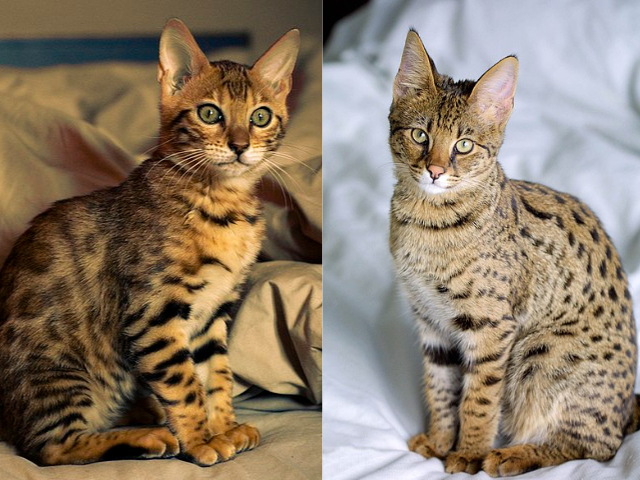
It wouldn’t be wrong to assume that a Savannah Bengal cat mix will look somewhere in between both.
The tall, slenderness of the Savannah somewhat curbed by the more stocky look of the Bengal.
Their temperaments are not too dissimilar, although expect crosses derived from early generations of either breed to create kittens that exhibit more wild-like traits.
Okay, let’s get to the questions.
Are Savannah and Bengal Cats The Same?
No, Savannah and Bengal cats are not the same.
As we’ve seen, Savannahs are the results of an original cross between a serval and a domestic cat.
Bengals came into being after an Asian leopard cat was bred with a domestic cat.
So their ancestral lines are different as are their general size, colouring and patterning (although this may not be so apparent to the untrained eye).
Are Savannah Cats Bigger Than Bengals?
In general, yes Savannah cats are bigger than Bengals.
This is particularly true of early generation cats.
However, later generation Savannahs are comparable in size to Bengals and other domesticated breeds.
Do Savannah and Bengal Cats Get Along?
There is no definitive answer to this.
But Savannah cats and Bengals can get along.
This will depend on the personality traits of the individuals involved, how they’re introduced and when.
Usually, it’s easier to introduce a new pet to a Bengal when it’s a kitten as adults Bengals can be protective of their territory.
Many people do acquire an additional companion cat to keep their Bengal company and help offset their demands for play and stimulation.
So there is no reason why this could not be a Savannah.
How Can I Tell The Difference Between A Bengal Cat and A Savannah Cat?
The most obvious difference between a Bengal cat and a Savannah cat is in body size and shape.
Generally, Savannahs are taller with long legs, long slender bodies and larger/longer ears.
This difference will be more pronounced in early generation cats.
Savannahs have solid spots, which Bengals can also have, but only true rossettes are found on Bengals.
Any Savannahs you see with rosettes are not pure and have acquired the trait from a Bengal.
But granted, they do look similar.
Do Savannah and Bengal Cats Make Good Pets?
Savannah and Bengal cats can make good pets, but it depends what a ‘good pet’ means to you.
Neither are known for being typical lap cats, although my own Bengal does have her moments.
If you want an intelligent, inquisitive pet that loves to play, but at times, will keep you on your toes (and that’s being polite), then you could consider either breed a good pet.
Summary
Deciding which breed to choose will essentially hang on which look you prefer and how much you’re prepared to spend.*
If you like your cats larger and sleeker then pick the Savannah- particularly early generation individuals.
Or if you prefer a breed with more variety in colour and patterning, then currently, a Bengal would be a better bet.
Individual temperaments differ even within breeds, but certainly later generation Savannah and Bengals share similar traits.
Cost may be a big factor.
If so, then a Bengal would make more financial sense.
However, you could always consider a Savannah Bengal cross- if you can find one…
So which will you go for?
*In some states there may be laws regarding ownership of Bengals and Savannahs so it’s important to check first.
Further Reading:
Resources:

